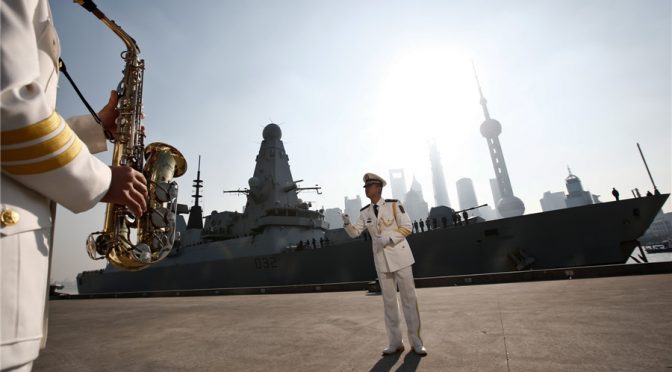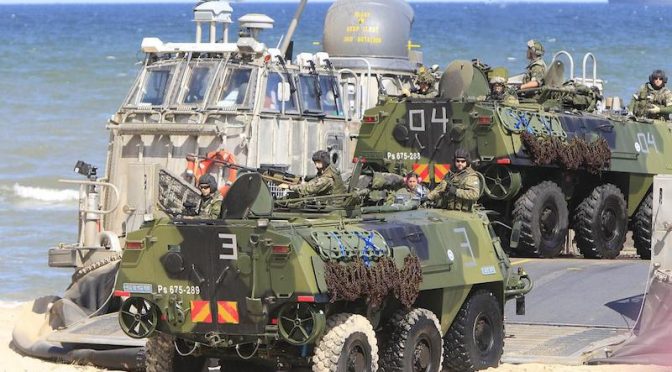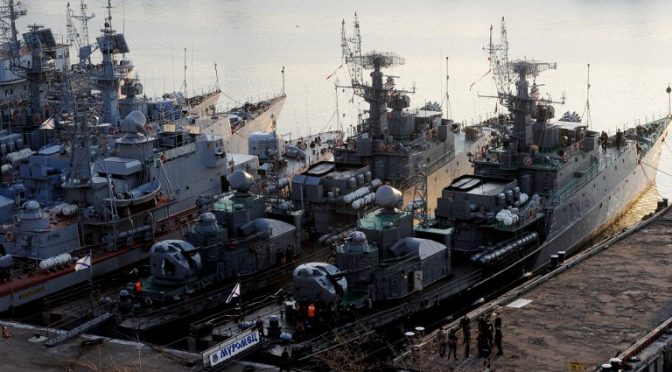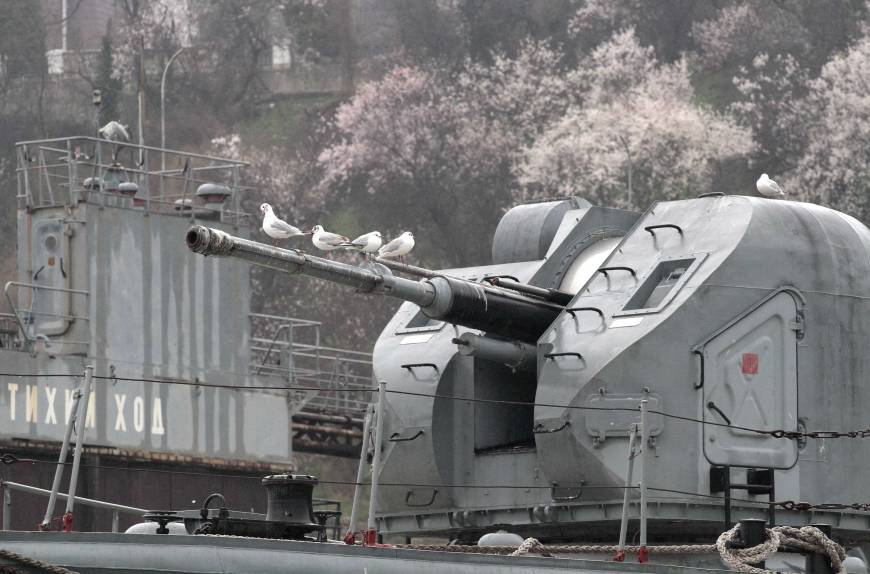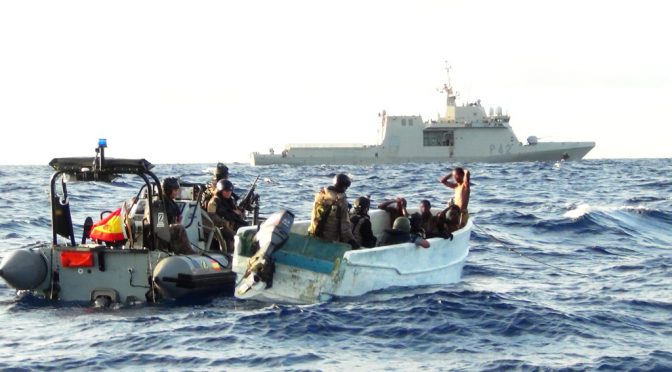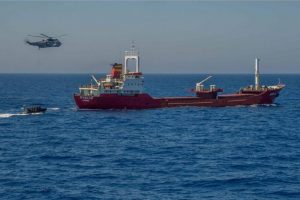European Maritime Security Topic Week
By Dave Andre
In the aftermath of the July 2016 ruling by the United Nation’s Permanent Court of Arbitration that broadly found China’s demarcation claims in the South China Sea to be without legal merit, it became apparent that legal decisions alone would do little to influence the status quo. Considering The Hague’s ruling against the strategic backdrop of power politics in the Asia Pacific, the need for a global maritime presence became clear. This presence connotes a significant maritime challenge for the European Union (EU), which remains a peripheral actor in the maritime security of the Asia-Pacific as several major powers oversee the geopolitical reordering of this critical region. The importance of the region for European trade and business, global economic stability, and international maritime security necessitates that the EU maintain more than just an economic and diplomatic presence in the region. Adding a dedicated maritime presence to the region will involve a balancing act between the competing interests of individual EU members while advancing a comprehensive and unified stance—this goes beyond simple matters of naval capability and capacity. As such, it is important that the international maritime community not treat this presence as a fait accompli, merely awaiting an executable maritime framework.
As the European Council on Foreign Relations summed up in 2013 in reference to Asia, the EU “does not have an automatic seat at the table and therefore must work all the harder to secure its own self-interests.”1 Since then little has changed, as China has increasingly expanded its territorial footprint, the EU has executed an uneven approach to maritime security in the Asia-Pacific region. This ineffectual response leaves Europe open to maritime security threats from afar.
The European Union’s Maritime Domain: A Unique Challenge
Given Europe’s long maritime history it is no surprise that the legal principle for freedom of the seas originated with a European—a Dutch lawyer to be specific—by the name of Hugo Grotius, who in the early seventeenth century wrote, ”Navigation was free to all and no one country could lay claim to the seas on the basis that their navigators were the first to sail on it.”2 Today, that principle exists within the United Nations Convention Law of the Sea (UNCLOS), which details provisions for navigation, archipelagic status and transit regimes, EEZs, territorial waters, and settlement of disputes. Today, the European Union faces a dynamic maritime environment with challenges ranging from border security to renewable resources and combating piracy. Of the EUs 28 member states, 22 have a combined coastline that extends 65,993 km encompassing the Mediterranean Sea, the Baltic Sea, the Black Sea, and the Atlantic Ocean.3 The length and breadth of this dynamic maritime environment, when coupled with the competing priorities of member states and coordination with non-member states, makes the EU’s maritime security strategy a unique challenge amongst maritime powers.
The EU addresses this complexity in the European Union’s Maritime Security Strategy (EUMSS), which recognizes the importance of protecting maritime interests worldwide while simultaneously recognizing that success depends on the ability to collaborate across regional and national levels.4 However, since the 2014 adoption of EUMSS, the EU has struggled to balance the myriad regional maritime issues with international maritime issues, showing that a unified maritime strategy for the global maritime domain is still far off. The unfolding situation in the South China Sea is perhaps the best example of the fissures and shortfalls inherent with the EU’s maritime strategy. The EU has so far remained outside the fray, issuing a tepid statement after the UN tribunal ruling in favor of the Philippines in July 2016.5 While many see this strategy as a case of prioritizing domestic issues over international issues, the issue is far more complex. The ever-evolving transatlantic relationship between the United States and Europe, the economic influence of China on Europe via initiatives like the One-Belt-One Road framework, and the declining naval power of European navies, all factor into Europe’s support of the maritime order in the Asia-Pacific.
Europe and Asia: A Complex Relationship
As a region, the Asia-Pacific is as dynamic as they come. Militarily, disputed islands, paramilitary forces, and militarization characterize the operating environment. Politically, Chinese realpolitik clashes with liberalism, pitting international governance against the rise of a regional hegemon. Meanwhile, from an economic standpoint the region is home to three of the world’s biggest economies, while over $5 trillion in global trade passes through the seas each year. This geo-political environment, coupled with the complex maritime geography of straits, archipelagic waters, and overlapping maritime claims means that international law is critical to maintaining an orderly system.6 Within this complex milieu lays the maritime challenge—protecting the Sea Lines of Communication (SLOC) critical to global economic prosperity.
This region holds significant interest for the European Union, but exactly what those interests are differs from member to member. These differences present difficulties for the EU’s development of a unified and actionable strategy in the South China Sea and the Southeast Asia region. China is the EU’s second largest trading partner, as a region ASEAN is the EU’s third largest trading partner, and South Korea, Japan, and India all place within the top ten. Collectively, this trade amounts to almost a trillion euros annually. Furthermore, there are more than 10,000 European companies operating within the Southeast Asia region.
The economic considerations are not solely defined by Europe looking east of the Suez; they are also largely influenced by China’s Eurasian ambitions. China’s One-Belt-One-Road initiative promises significant investment in Europe, especially the struggling economies of the South and East. Likewise, investments by companies such as the state-owned China Ocean Shipping Company (COSCO), which is upgrading the port in Piraeus, Greece, illustrate that this economic influence extends past mere business ventures.7 While the One-Belt-One-Road initiative is unlikely to radically alter the geography of trade routes and investment in port upgrades will not alter Greece’s naval posture, these activities do have the potential of altering and influencing the economic interdependence of EU member states. This creates scenarios where Europe needs to tread lightly as they balance economic and diplomatic interests against security interests, while simultaneously recognizing that the preferred balance will be different depending on the individual country.
European Diplomatic Efforts in the Asia-Pacific Maritime Domain
The divisions are not limited to economics. Politically, the EU has struggled to speak with one voice regarding issues within the Asia-Pacific. The EU’s presence in the Asia-Pacific is a complex web of arrangements, policies, dialogues, and statements that seek to balance the competing interests of individual members while advancing a comprehensive and unified stance. Starting in 2007, there have been a number of policy developments pertaining to the EU’s development of a comprehensive maritime strategy. In 2007, the adoption of the Blue Book, an Integrated Maritime Policy laid the groundwork for operational cooperation among member states. While not specifically addressing security concerns, the focus on trade and fisheries provided a template for future maritime security initiatives.8 A series of initiatives followed—Marine Strategy Framework Directive (2008) and the Limassol Declaration (2012)—that recognized the significance of dialogue and cooperation within the regional and international maritime realm as well as the importance of the legal framework laid out by UNCLOS. These policy trends expanded and in 2012, the EU’s Foreign and Security Policy in East Asia proffered guidelines for resolving disputes within the framework of UNCLOS and stresses the importance of freedom of navigation.9 The policy also notes the economic interdependence between the EU and East Asia, the potentially negative impact of competitive nationalism represented by the South China Sea issues, and the complexity of trans-Atlantic relations with the United States and extra-regional partners like Russia, Australia, New Zealand, and India.10 Furthermore, the Treaty of Amity and Cooperation in Southeast Asia (TAC), which the EU signed in July 2012, provides the framework for peaceful interactions in the region. Taken together these policies clearly articulate that EU interests are closely tied to those of the Asia-Pacific and the international maritime legal framework.

Beyond policies, the EU maintains a public dialogue—albeit uneven—that further emphasizes and recognizes the importance of the Asia-Pacific and an international maritime framework. It was at the 2013 Shangri-La dialogue in Singapore that the EU was represented as a whole for the first time by High Representative Catherine Ashton. During the dialogues, she referred to the EU’s long-term security plans and comprehensive approach in Asia. Missing from the 2014 dialogues, the EU’s message was one that prioritized concerns in Ukraine, the Middle East, and North Africa over those in far off Asia. While this prioritization of time and resources is notable, even wise, it did little to assuage Asian nations that may be looking to the EU as a model of multilateralism and an alternative to the United States. A notably different tone was struck in the 2015 dialogues, as EU High Representative Federica Mogherini discussed the EU’s, “strong interest in global security.”11 Representative Mogherini made specific mention of freedom of navigation, SLOCs, international law and the importance of promoting cooperation of confrontation and the need for “everyone to play by the same rules.”12
In addition to the Shangri-La dialogues, the EU, France, Germany, Italy, and U.K. signed the G-7 Foreign Ministers’ Declaration on Maritime Security which declares their commitment to “freedoms of navigation and over flight” and to an “international maritime order based upon the principles of international law, in particular as reflected in UNCLOS.”13 At the 2016 G7 Summit in Japan, members reiterated concern “about the situation in the East and South China Seas” and emphasized “the fundamental importance of peaceful management and settlement of disputes.”14 Unsurprisingly, the 2016 Shangri-La dialogues a month later discussed “China’s continued land reclamation and military build-up in the strategic maritime area” at length.i Within this context, the French Defense Minister made clear that joint EU patrols were forthcoming.15 However, a month later, the UN tribunal ruling in favor of the Philippines saw the EU struggle to issue a joint statement. And to say the resulting statement was benign is an understatement; among other things it failed to make any mention of sovereignty. Since then, the EU has been notably silent regarding the South China Sea despite growing evidence of China’s continued militarization of a number of islands.
European Presence in the Asia Pacific
Despite the attempts at providing a unified response under a common defense policy, the most active aspects of Europe’s involvement in the Asia Pacific come in bilateral terms. France has made numerous overtures toward supporting FONOPs in the South China Sea. The UK’s Royal Navy has perhaps the largest and most codified presence in the Asia-Pacific, though it is a shadow of the presence that it was until the waning years of the last century. The Five Power Defense Arrangement, the most notable European-Asian arrangement, is a multilateral agreement between the Commonwealth counties of U.K., Australia, New Zealand, Singapore and Malaysia whereby all powers will consult one another in the event of an attack (actual or threatened) against Malaysia or Singapore. This consultation brings no promise of military action or support, but nonetheless is pertinent for its formal acknowledgement of European-Asian mutual interests. Furthermore, four European countries—Denmark, the Netherlands, Norway, and the U.K.—are members of the Regional Cooperation Agreement on Combating Piracy and Armed Robbery against Ships in Asia (ReCAAP).16 ReCAAP, a multilateral counter-piracy operation that stretches from the Gulf of Aden to the East China Sea illustrates the naval capability of some European powers.17 Additionally, in 2016 Denmark, France, Germany, Italy, Netherlands, Norway, and the U.K. participated in the Rim of the Pacific (RIMPAC) maritime warfare exercise, signaling their support for Asian maritime security.18 Additionally, there are multilateral examples of EU maritime involvement: the Indian Ocean earthquake and tsunami in 2004, the Fukushima tsunami that occurred in 2010, and Typhoon Haiyan in the Philippines in 2014 all saw EU involvement.
In Conclusion: It’s Time to Grab a Seat at the Table
Despite policies, dialogues, and statements, the EU lacks a consistent presence in the region, which undermines their ability to influence political and economic events as they unfold. Alongside the 2016 UN tribunal ruling and discussions for a South China Sea Code of Conduct, the EU is losing its seat at the table as the maritime picture takes shape. If the EU expects to maintain influence in the Asia-Pacific it must accept that the geopolitical instability that defines the South China Sea and Asia-Pacific region requires a naval presence to manage risk, promote international order, and decrease the chances of armed conflict.
Setting aside EU institutional politics, there are a number of EU members who have navies capable of global power projection—France, Germany, Italy, the U.K., and Spain. While some members may need to operate in a coalition due to refueling limitations, the capability remains. Overall, the European picture reveals a maritime mindset more focused on the near than the far. This is shortsighted in terms of politics, economics, and military capabilities. Not least because any significant rebalance toward Asia without a corresponding increase in shipbuilding would require a considerable shift in resource allocation. Reversing the current decline in shipbuilding across Europe will take significant and immediate initiative. The EU should take advantage of their long-standing relationship with the U.S. concerning maritime security and their experience working alongside global partners to engender a workable maritime strategy in the South China Sea and the Asia Pacific. With the U.S. increasing its presence in the Europe, there is opportunity for Europe to reinvigorate the Transatlantic Partnership that has defined U.S.-European relations for decades.
Politically, no entity is better poised than the EU to understand the power dynamics and challenges that a regional organization faces when countering the influence of a rising—or in the case of Russia—resurgent hegemonic power. There are relevant lessons to be drawn from the territorial aggression that Russia exhibited in the annexation of the Ukraine. Most notably, that a nation that feels compelled to assume power in a region that they historically view as theirs will not be thwarted by politics alone. Reactionary policies are no substitute for proactive plans. The European Union’s hodgepodge of arrangements, policies, dialogues, and statements regarding the South China Sea, coupled with Chinese economic influence, declining naval power, and an inability to speak and act with one voice are eroding European influence at a time when a new regional order is taking shape in the Asia-Pacific region. To counter this erosion of influence the EU needs a strategy that moves past mere statements that support international norms and the rules laid out in UNCLOS and establish a maritime presence that protects SLOCs throughout the Asia-Pacific.
LT David M. Andre is a former Intelligence Specialist, and has served as an Intelligence Officer and Liaison Officer assigned to AFRICOM. He is currently serving as N2 for COMDESRON SEVEN in Singapore. He can be reached at dma.usn@gmail.com.
The views expressed above are the authors’ alone and do not reflect the official views and are not endorsed by the United States Navy, the Department of the Navy, the Department of Defense, or any other body of the United States Government.
References
1. “What is Europe’s role in Asia-Pacific?” European Council on Foreign Relations, http://www.ecfr.eu/article/commentary_what_is_europes_role_in_asia_pacific
2. Bruce Farthing, Farthing on International Shipping, Business of Shipping Series, LLP, London Hong Kong, 1997, p. 7.
3. In comparison, the United States has 19,924 km of coastline, while Russia has 37,653 km.
4. European Commission, “European Union Maritime Security Strategy: Responding Together to Global Challenges,” https://ec.europa.eu/maritimeaffairs/policy/maritime-security_en
5. “Declaration by the High Representative on behalf of the EU on the Award rendered in the Arbitration between the Republic of the Philippines and the People’s Republic of China,” European Council, http://www.consilium.europa.eu/en/press/press-releases/2016/07/15-south-china-sea-arbitration/
6. S. Rajaratnam School of International Studies Policy paper. Good Order at Sea. https://www.rsis.edu.sg/wp-content/uploads/2014/07/PR090427_Good_Order_at_Sea_in_SEA.pdf
7. Netherlands Institute of International Relations Clingendael Policy Paper. China’s Maritime Silk Road. https://www.clingendael.nl/sites/default/files/China_Maritime_Silk_Road.pdf.
8. Internaitonal Maritime Security Law by James Kraska, Raul Pedrozo, p. 62.
9. EU-Asia Centre, “South China Sea: Background Note,” http://www.eu-asiacentre.eu/documents/uploads/pub_112_south_china_sea_background_note.pdf.
10. “Guidelines on the EU’S Foreign and Security Policy in East Asia”, Council of European Union, http://eeas.europa.eu/archives/docs/asia/docs/guidelines_eu_foreign_sec_pol_east_asia_en.pdf
11. Speech by High Representative/Vice-President Federica Mogherini at the IISS Shangri-La Dialogue 2015 https://eeas.europa.eu/headquarters/headquarters-homepage/6254_en
12. Ibid.
13. G7 Foreign Ministers’ Declaration on Maritime Security in Lübeck, 15 April 2015, Federal Foreign Office, http://www.auswaertiges-amt.de/EN/Infoservice/Presse/Meldungen/2015/150415_G7_Maritime_Security.html?nn=479796.
14. Whitehouse, “G7 Ise-Shima Leaders’ Declaration,” https://obamawhitehouse.archives.gov/the-press-office/2016/05/27/g7-ise-shima-leaders-declaration.
15. Kelvin Wong: Reflections on the 2016 Shangri-La Dialogue, https://www.iiss.org/en/shangri-la%20voices/blogsections/2016-588c/kelvin-wong—reflections-on-the-2016-shangri-la-dialogue-2789.
16. Regional Cooperation Agreement on Combating Piracy and Armed Robbery against Ships in Asia (ReCAAP), http://www.recaap.org/AboutReCAAPISC.aspx.
17. “Bridging Asia and Europe Through Maritime Connectivity China’s Maritime Silk Road and Indonesia’s Maritime Axis” European Institute for Asian Studies. March 2015. http://www.eias.org/wp-content/uploads/2016/02/Bridging_Asia_Europe_2015.pdf
Featured Image: Members of the welcoming ceremony band play as British Royal Navy destroyer HMS Daring arrives at a port area of Huangpu River in Shanghai December 10, 2013. (Photo by Yang Yi/Asianewsphoto)

